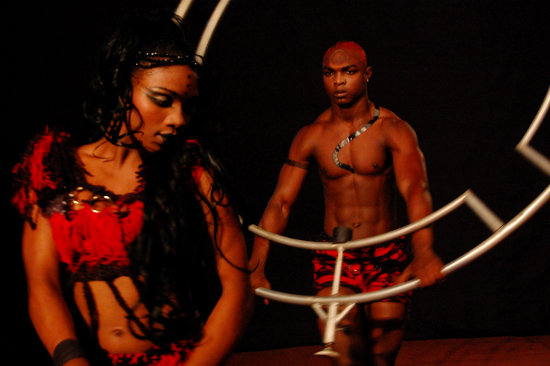
With a dearth of circus or physical theatre work in the Brighton Festival, it came down to the Fringe to fill the gaps. Enter the Freerange: a great red plastic geodesic dome which was parked on a church green in central Brighton—a temporary refuge for circus, variety and cabaret. Although some companies programmed struggled with the challenges that this cavernous and somewhat bleak space offered, it proved to be the perfect venue for Circolombia, whose upbeat and streetwise show Urban energised every square inch of the place.
The company is a product of the Circo Para Todos social circus project for Colombia’s street children. Had this project just satisfied its aims of ‘providing an alternative avenue to social and professional development for vulnerable youth through the teaching of circus arts’, then that would have been achievement enough. But the professional training school, then young company, that has emerged from this venture has proved itself to be world-standard.
Urban starts with an almost empty stage—the only thing occupying it is a large oil drum turned on its side. The beats kick in, and on bounce half a dozen young men in ripped-and-torn togs, faces smeared with white chalk. What starts as a b-boy exchange of dance moves escalates into a fight to become leader of the pack—a great excuse for some serious acrobatics, bodies building human towers and leaping through space alarmingly close to the audience (the front row is on the stage with them, and performers are often close to landing in our laps).
Exit ‘our gang’, leaving just the barrel—which turns out to be home to an almost-naked man smudged with blue and yellow body paint, a rapper whose angry words set the scene for the emergence of the second street gang. This lot are dressed in pristine white vests, and are wielding sticks and ropes. Cue a lively skipping act, in which both gangs try to outdo each other with ever-snazzier moves.
Lurking on the fringes of the action is a slight boy who is obviously the runt of the litter—hood pulled over his head obscuring his face, tugging his too-large jacket close to his body, he’s shunned by the others, and edges cautiously to the front of the stage. Then comes the reveal: ‘he’ is a ‘she’. She strips down to a shiny bodysuit and struts the stage, then there’s a breathtakingly beautiful acrobalance-with-hoop duet with oil drum man followed by a Cinderella moment as someone brings her a pair of silver stilettos, in which she performs a sinuous solo aerial straps routine—circus in heels seems to be something of a thing of the moment, but to my eyes it’s a shame that the only female performer in the show has gone down this road. Her placing in the action as the desirable ‘other’ is perhaps inevitable, but it would have been good to have expectations challenged. And the following ensemble scene is a particularly uncomfortable moment—a young woman being passed around the hands and bodies of a dozen crowing young men is an image that has connotations that can’t be avoided, although I suppose it could be argued that the subject matter of the piece is streetlife in the Colombian city of Cali, and the playing out of the threat of violence (be it male-on-male or male-on-female) is an inherent theme.
After that we are well into the swing of things—the gang rivalry between the ‘white vests’ and the ‘black vests’ gets played out through ever-more astounding acrobalance and acrobatic routines; dance and theatrical elements of the piece are developed through a very lovely dark and druggy dance-with-Death scene with candles, disturbing carnival masks, skeleton costumes, and pounded oil drums; there’s a pretty good Roue-Cyr (big hoop) piece and the grand finale is a (literally) ground-shaking act. Although the story seems to have fallen by the wayside by this point, no one is too bothered as the onstage energy has soared to fever pitch.
Cue standing ovation—there’s no doubt that the audience are wowed: brilliant circus and street dance skills integrated with an amazing Latin-rap soundtrack. What's not to like? The nagging doubts remaining are those that tag much circus-theatre: how to balance the skills with the story (starts well here, but falls apart); how to justify and integrate the circus equipment (again, the intro of the skipping ropes was great, but why, from a dramaturgical point of view, are teeterboards brought on?); and the challenge of avoiding the pitfalls of dealing with serious subjects flippantly. The darkness of much of the subject matter was referenced rather than engaged with—although perhaps for those who have encountered the violence of the streets of Cali, where ‘dance and music are the safety valves of everyday life’, a light touch is what is needed.